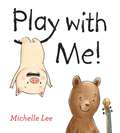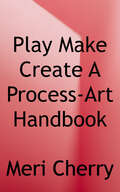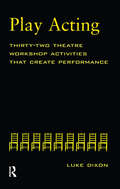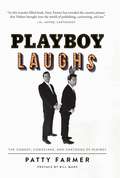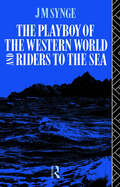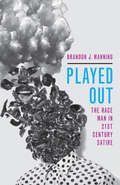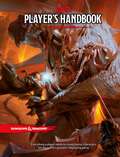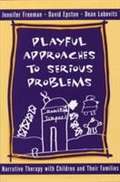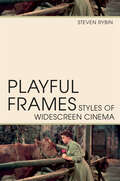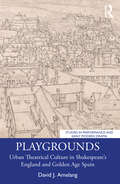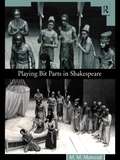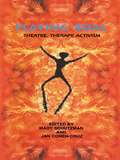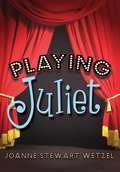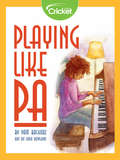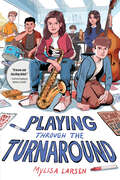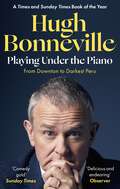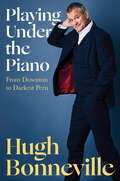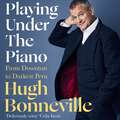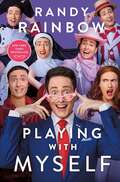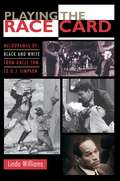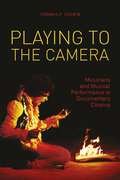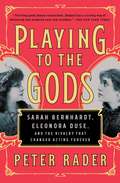- Table View
- List View
Play with Me!
by Michelle LeePlaytime means very different things to these two spirited friendsPip is full of ideas for what to play: Dress up! Magicians! Dolls! Only, Nico doesn&’t want to play any of them, and Pip gets mad. REALLY mad. But don&’t worry—Nico finds the perfect way for them to play together. Michelle Lee&’s irresistible characters show that finding a way to play together will always hit the right note.
Play, Make, Create, A Process-art Handbook: With 43 Art Invitations for kids creative activities and projects to inspire free thinking, mindfulness, and curiosity
by Meri CherryPacked with joyful and educational art experiences for kids, Play, Make, Create offers fun and engaging imaginative activities focused on the fun and reward of creating, not just producing a final project. Founded in a process-based philosophy, this unique book includes more than 40 activities set up as invitations, or thoughtfully designed prompts to explore, create, and play.
Play-Acting: A Guide to Theatre Workshops
by Luke DixonPlay-Acting is an inspired book of theatrical beginnings-jumping-off points for actors, teachers, and directors. Drawing upon his thirty years of designing and leading theater workshops, Luke Dixon goes to the heart of contemporary theater practice. Whether drawing upon Japanese butoh, Shakespearean verse, or African rhythms, these thirty-two workshops cover a wide range of activities-voice warm-ups, body work, the exploration of theatrical space, life games, dreamtime, sense and chakras, working with the spine, and much, much more. More than a collection of exercises, Play-Acting is constructed to take the user on a journey from learning about the anatomy of the individual actor's body to the performance of narrative by a group of actors. With tips on what you might expect to experience as an actor, teacher, or director, along with ideas on how to exploit the unexpected in performance, Play-Acting is a book to be read again and again.
Playboy Laughs: The Comedy, Comedians, And Cartoons Of Playboy
by Patty FarmerFollowing her success with Playboy Swings, Patty Farmer looks at Playboy’s relationship with comedians and cartoonists in her new book Playboy Laughs. Playboy Laughs invites readers onto the sets of the organization’s groundbreaking TV shows, Playboy Penthouse and Playboy After Dark. These popular variety series brought top-tier comedians, impressionists, and monologists—as well as the finest musicians—into people’s homes each week. Readers will learn how before he ever dreamed of conquering the magazine publishing world—and along the way establish a worldwide brand—Hugh Hefner harbored aspirations of making his mark in the world as a cartoonist. Playboy Laughs delves into the darker aspects of the time as well, tackling the ways Playboy and its comedy stars helped break down social and racial barriers as well as sexual ones. Known for her devotion to meticulous research and clear, honest storytelling, Farmer has gained the full cooperation of the Playboy organization—and Hugh Hefner himself—making this not only an entertaining read but a trustworthy history of an under-appreciated aspect of American comic culture.
Playboy of the Western World: A Comedy In Three Acts (Classic, 20th-century, Penguin Ser.)
by J.M SyngeFirst published in 1979. Routledge is an imprint of Taylor & Francis, an informa company.
Playboys and Killjoys: An Essay on the Theory and Practice of Comedy
by Harry LevinHarry Levin--one of America's major literary critics--offers a brilliant and original study of the whole world of comedy, concentrating on playwrights through the centuries, from Aristophanes and Plautus in classical times to Bernard Shaw and Bertolt Brecht and their recent successors. Viewing the comic repertory as a richly varied yet broadly unified whole, Levin provides a synthesis of theories and practice. Isolating two fundamental aspects of comedy--the ludicrous and irreverent "playboy," whom we laugh with, and the ridiculous and forbidding "killjoy," whom we laugh at--he traces the dialectical interplay of these components throughout history and across various cultures and media. While mainly focusing on the plays and the stage, with discussions of such major dramatists as Shakespeare, Ben Jonson, Moliere, and William Congreve, Levin also includes essays on such related topics as humor, satire, and games.
Played Out: The Race Man in Twenty-First-Century Satire
by Brandon J. ManningDating back to the blackface minstrel performances of Bert Williams and the trickster figure of Uncle Julius in Charles Chesnutt’s Conjure Tales, black humorists have negotiated American racial ideologies as they reclaimed the ability to represent themselves in the changing landscape of the early 20th century. Marginalized communities routinely use humor, specifically satire, to subvert the political, social, and cultural realities of race and racism in America. Through contemporary examples in popular culture and politics, including the work of Kendrick Lamar, Key and Peele and the presidency of Barack Obama and many others, in Played Out: The Race Man in 21st Century Satire author Brandon J. Manning examines how Black satirists create vulnerability to highlight the inner emotional lives of Black men. In focusing on vulnerability these satirists attend to America’s most basic assumptions about Black men. Contemporary Black satire is a highly visible and celebrated site of black masculine self-expression. Black satirists leverage this visibility to trouble discourses on race and gender in the Post-Civil Rights era. More specifically, contemporary Black satire uses laughter to decenter Black men from the socio-political tradition of the Race Man.
Player's Handbook (Dungeons & Dragons)
by Wizards of the Coast TeamDungeons & Dragons immerses you in a world of adventure. Explore ancient ruins and deadly dungeons. Battle monsters while searching for legendary treasures. Gain experience and power as you trek across uncharted lands with your companions.
Players and Their Pets: Gaming Communities from Beta to Sunset
by Mia Consalvo Jason BegyIn the world of massively multiplayer online games (MMOGs), Faunasphere was but a blip on the screen in its short public life from 2009 to 2011. Its devoted players, many of them middle-aged women, entered a world that did not build on common fantasy or science-fiction tropes. There was no evil to defeat or realms to conquer, only friendly animals to care for and pollution to fight.In Players and Their Pets, Mia Consalvo and Jason Begy argue that its very difference makes it critically important—even more so than the large, commercially successful games such as World of Warcraft that have all too often shaped game studies discourse. Consalvo and Begy demonstrate how the beta period of an MMOG can establish social norms that guide how the game is played. They also show how a game&’s platform creates expectations for how the game will work and who is playing it—and what happens when those expectations clash with the reality. Even while telling the story of this particular game and its predominantly female players, however, Players and Their Pets cautions against oversimplifying players based on their gender. Faunasphere&’s playerbase enjoyed diverse aspects of the game, for varied reasons. No other game studies book tracks the entire life cycle of an online game to examine how the game evolved in terms of design as well as how its player community responded to changes and events. The brief life of Faunasphere makes this possible.
Playful Approaches to Serious Problems: Narrative Therapy with Children and their Families
by David Epston Jennifer Freeman Dean LobovitsThe "grown-up talk" of therapy is likely to turn off children - especially if it focuses on their problematic behavior. The highly effective techniques of narrative therapy include children by respecting their unique language, stories, and views of the world. This book describes a basic theory of collaborative narrative play, as well as verbal and nonverbal techniques that clear the way for stories of hope, possibility, and change. Compelling case examples, drawn from the authors' work, will appeal to parents and educators as well as therapists.
Playful Frames: Styles of Widescreen Cinema (Techniques of the Moving Image)
by Steven RybinA widescreen frame in cinema beckons the eye to playfully, creatively roam. Such technology also gives inventive filmmakers room to disrupt and redirect audience expectations, surprising viewers through the use of a wider, more expansive screen. Playful Frames: Styles of Widescreen Cinema studies the poetics of the auteur-driven widescreen image, offering nimble, expansive analyses of the work of four distinctive filmmakers – Jean Negulesco, Blake Edwards, Robert Altman, and John Carpenter – who creatively inhabited the nooks and crannies of widescreen moviemaking during the final decades of the twentieth century. Exploring the relationship between aspect ratio and subject matter, Playful Frames shows how directors make puckish use of widescreen technology. All four of these distinctive filmmakers reimagined popular genres (such as melodrama, slapstick comedy, film noir, science fiction, and horror cinema) through their use of the wide frame, and each brings a range of intermedial interests (painting, performance, and music) to their use of the widescreen image. This study looks specifically at the technological underpinnings, aesthetic shapes, and interpretive implications of these four directors’ creative use of widescreen, offering a way to reconsider the way wide imagery still has the potential to amaze and move us today.
Playgrounds: Urban Theatrical Culture in Shakespeare’s England and Golden Age Spain (Studies in Performance and Early Modern Drama)
by David J. AmelangThis book compares the theatrical cultures of early modern England and Spain and explores the causes and consequences not just of the remarkable similarities but also of the visible differences between them. An exercise in multi-focal theatre history research, it deploys a wide range of perspectives and evidence with which to recreate the theatrical landscapes of these two countries and thus better understand how the specific conditions of performance actively contributed to the development of each country’s dramatic literature. This monograph develops an innovative comparative framework within which to explore the numerous similarities, as well as the notable differences, between early modern Europe’s two most prominent commercial theatre cultures. By highlighting the nuances and intricacies that make each theatrical culture unique while never losing sight of the fact that the two belong to the same broader cultural ecosystem, its dual focus should appeal to scholars and students of English and Spanish literature alike, as well as those interested in the broader history of European theatre. Learning from what one ‘playground’ – that is, the environment and circumstances out of which a dramatic tradition originates – reveals about the other will help solve not only the questions posed above but also others that still await examination. This investigation will be of great interest to students and scholars in theatre history, comparative drama, early modern drama, and performance culture.
Playing Bit Parts in Shakespeare
by Professor M Mahood M.M. MahoodPlaying Bit Parts in Shakespeare is a unique survey of the small supporting roles - such as foils, feeds, attendants and messengers - that feature in Shakespeare's plays. Exploring such issues as how bit players should conduct themselves within a scene, and how blank verse or prose may be spoken to bring out the complexities of character-definition, Playing Bit Parts in Shakespeare brings a wealth of insights to the dynamic of scenic construction in Shakespeare's dramaturgy. M.M. Mahood explores the different functions of minimal characters, from clearing the stage to epitomizing the overall effect of the comedy or tragedy, and looks at how they can extend the audience's knowledge of the social world of the play. She goes on to describe the entire corpus of minimal roles in a selection of six plays: * Richard III * The Tempest * King Lear * Antony & Cleopatra * Measure for Measure * Julius Caesar This new edition comes enhanced with a new Appendix, 'Who Says What', especially designed to aid directors in making decisions about the speaking parts of the minimal characters. It also comes complete with an index of characters (including line references) as well as a detailed general index. An invaluable aid for directors and actors in the rehearsal room, this perceptive and informative volume is equally of interest to students studying and writing about Shakespeare's plays.
Playing Boal: Theatre, Therapy, Activism
by Jan Cohen-Cruz Mady SchutzmanPlaying Boal examines the techniques in application of Augusto Boal, creator of Theatre of the Oppressed, Brazilian theatre maker and political activist. This text looks at the use of the Theatre of the Oppressed exercises by a variety of practitioners and scholars working in Europe, North America and Canada. It explores the possibilities of these tools for "active learning and personal empowerment; co-operative education and healing; participatory theatre and community action." This collection is designed to illuminate and invigorate discussion about Augusto Boal's work and the transformative potential of theatre. It includes two interviews with Boal, and two pieces of his own writing.
Playing Juliet
by Joanne Stewart WetzelBeth Sondquist, age twelve and a half, dreams of playing the part of Juliet. For now she’s just the cat in Cinderella, but one day, she’s determined to become a real actress. But all her hopes for an acting career come crashing down when the Oakfield Children’s Theater is slated to be closed. Its new owner has decided to make it into an adult theater, a real theater. Beth and her best friend, Zandy, are willing to do whatever it takes to save the theater, but their plans quickly go awry. When Beth’s father catches her sneaking back into her bedroom window well past bedtime, Beth is in big, big trouble. With eviction looming, the children’s theater director decides to close the theater with the same play the theater opened with fifty years ago--Romeo and Juliet. But Beth’s grounded for the next two weeks, and she won’t be able to try out. How will Beth pull off playing Juliet if she can’t even make tryouts? Playing Juliet is funny and honest and celebrates bravery and doing the right thing even when it gets you into trouble. It’s about having the courage to go after what you want and making your dreams come true. It’s also about friendship and family. As an almost-thirteen-year-old, Beth has a unique bond with thirteen-year-old Juliet, and she eventually recognizes just how silly and immature Juliet’s decisions are. Only Beth can play Juliet as the kid that she is. With a little bit of luck, maybe she’ll get her chance.
Playing Like Pa
by Pam BachorzStella listens to her grandpa play piano at the Tulip Café for the final time before he retires.
Playing Through the Turnaround
by Mylisa LarsenIn a timely, insightful story told with sparkling wit and heart, young musicians protesting plans for budget cuts navigate miscalculations, indifferent adults, and unexpected loss as they discover the power of speaking out and the value of listening.“A brave and dazzling debut, this timely novel is a blueprint for hope.”—Katherine Applegate, Newbery Medalist and best-selling author of The One and Only Ivan“Keen and clear and fiercely funny.”—Linda Sue Park, Newbery Medalist and best-selling author of A Long Walk to Water“Brilliant, sharp, comic, poignant, and true.”— Gary D. Schmidt, two-time Newbery Honor-winning author of The Wednesday Wars“A splendid novel filled with honesty and heart.”—Karina Yan Glaser, best-selling author of the Vanderbeekers series.Fifth period is hands down the best time of day in Connor U. Eubanks Middle School, because that’s when Mr. Lewis teaches Jazz Lab. So his students are devastated when their beloved teacher quits abruptly. Once they make a connection between budget cuts and Mr. Lewis’s disappearance, they hatch a plan: stop the cuts, save their class.Soon, they become an unlikely band of crusaders, and their quest quickly snowballs into something much bigger—a movement involving the whole middle school. But the adults in charge seem determined to ignore their every protest. How can the kids make themselves heard?
Playing Under the Piano: From Downton to Darkest Peru
by Hugh BonnevilleHugh Bonneville is one of Britain's most accomplished actors, whose credits include Downton Abbey, W1A and the Paddington films. 'I don't remember when I last read a book that gave me so many laughs' Christina Patterson, Sunday Times'A writer of considerable urbanity and wit' Lynn Barber, Daily Telegraph'Deliciously witty' Celia Imrie'Utterly charming' Jack Whitehall'Funny, touching, revealing' Gyles Brandreth'A great read' Graham Norton'A gorgeous book' Richard Curtis'Beautiful. Touching. And funny' Gary OldmanHugh Bonneville is one of Britain's most accomplished actors, familiar to audiences worldwide for his roles in Notting Hill, the Paddington films and Downton Abbey. From getting his big break as Third Shepherd in the school nativity play, to mistaking a Hollywood star for an estate agent, Hugh creates a brilliantly vivid picture of a career on stage and screen. What is it like working with Judi Dench and Julia Roberts, or playing Robert de Niro's right leg, or not being Gary Oldman, twice? A wickedly funny storyteller, Hugh also writes with poignancy about his father's dementia and of his mother, whose life in the secret service only emerged after her death. Whether telling stories of working with divas, Dames or a bear with a penchant for marmalade, this is a richly entertaining account of his life as an actor.
Playing Under the Piano: From Downton to Darkest Peru
by Hugh BonnevilleHugh Bonneville is one of Britain's most accomplished actors, whose credits include Downton Abbey, W1A and the Paddington films. 'Deliciously witty' Celia Imrie'Utterly charming' Jack Whitehall'Funny, touching, revealing' Gyles Brandreth'A gorgeous book' Richard Curtis'Beautiful. Touching. And funny' Gary Oldman'Charming, joyous and entertaining' Griff Rhys Jones'Shows a great verve for storytelling' The Independent Hugh Bonneville is one of Britain's most accomplished actors, familiar to audiences worldwide for his roles in Notting Hill, the Paddington films and Downton Abbey. From getting his big break as Third Shepherd in the school nativity play, to mistaking a Hollywood star for an estate agent, Hugh creates a brilliantly vivid picture of a career on stage and screen. What is it like working with Judi Dench and Julia Roberts, or playing Robert de Niro's right leg, or not being Gary Oldman, twice? A wickedly funny storyteller, Hugh also writes with poignancy about his father's dementia and of his mother, whose life in the secret service only emerged after her death. Whether telling stories of working with divas, Dames or a bear with a penchant for marmalade, this is a richly entertaining account of his life as an actor.
Playing Under the Piano: From Downton to Darkest Peru
by Hugh BonnevilleA moving, laugh-out-loud memoir from one of today&’s best-loved British actors, whose credits include Downton Abbey, Notting Hill, and Paddington.From getting his big break as Third Shepherd in the school nativity play, to mistaking a Hollywood star for an estate agent, Hugh Bonneville creates a brilliantly vivid picture of a career on stage and screen. What is it like working with Judi Dench and Julia Roberts, or playing Robert De Niro&’s right leg, or not being Gary Oldman, twice? A wickedly funny storyteller, Bonneville also writes with poignancy about his father&’s dementia and of his mother, whose life in the secret service emerged only after her death. Whether telling stories of working with divas, Dames, or a bear with a penchant for marmalade, this is a richly entertaining account of his life as an actor.
Playing Under the Piano: From Downton to Darkest Peru
by Hugh BonnevilleThis exclusive recording includes 6 extended chapters that are unique to the audiobookHugh Bonneville is one of Britain's most accomplished actors, whose credits include Downton Abbey, W1A and the Paddington films. 'Deliciously witty' Celia Imrie'Utterly charming' Jack Whitehall'Funny, touching, revealing' Gyles Brandreth'A gorgeous book' Richard Curtis'Beautiful. Touching. And funny' Gary Oldman'Charming, joyous and entertaining' Griff Rhys Jones'Shows a great verve for storytelling' The Independent Hugh Bonneville is one of Britain's most accomplished actors, familiar to audiences worldwide for his roles in Notting Hill, the Paddington films and Downton Abbey. From getting his big break as Third Shepherd in the school nativity play, to mistaking a Hollywood star for an estate agent, Hugh creates a brilliantly vivid picture of a career on stage and screen. What is it like working with Judi Dench and Julia Roberts, or playing Robert de Niro's right leg, or not being Gary Oldman, twice? A wickedly funny storyteller, Hugh also writes with poignancy about his father's dementia and of his mother, whose life in the secret service only emerged after her death. Whether telling stories of working with divas, Dames or a bear with a penchant for marmalade, this is a richly entertaining account of his life as an actor.
Playing With Myself
by Randy RainbowAn intimate and light-hearted memoir by viral sensation and three-time Emmy-nominated musical comedian Randy Rainbow that takes readers through his life―the highs, the lows, the lipstick, the pink glasses, and the show tunes. <p><p> Randy Rainbow, the man who conquered the Internet with a stylish pair of pink glasses, an inexhaustible knowledge of Broadway musicals, and the most gimlet-eyed view of American politics this side of Mark Twain finally tells all in Playing with Myself, a memoir sure to cause more than a few readers to begin singing one of his greatest hits like “A Spoonful of Clorox” or “Cover Your Freakin’ Face.” <p><p> As Randy has said, “There’s so much fake news out there about me. I can’t wait to set the record straight and finally give people a peek behind the green screen.” And set the record straight he does. Playing with Myself is a first-hand account of the journey that led Randy Rainbow from his childhood as the over-imaginative, often misunderstood little boy who carried a purse in the second grade to his first job on Broadway as the host at Hooters and on to the creation of his trademark comedy character. In chapters titled “Pajama Bottoms” (a look back at the days when he wore pajama bottoms on his head to pretend he was Dorothy in The Wizard of Oz), “Yes, It’s My Real Name, Shut Up!” (no explanation necessary...) and “Pink Glasses” (a rose-colored homage to his favorite accessory), Playing with Myself is a memoir that answers the question “Can an introverted musical theatre nerd with a MacBook and a dream save the world, one show tune at a time?”
Playing the Race Card: Melodramas of Black and White from Uncle Tom to O. J. Simpson
by Linda WilliamsThe black man suffering at the hands of whites, the white woman sexually threatened by the black man. Both images have long been burned into the American conscience through popular entertainment, and today they exert a powerful and disturbing influence on Americans' understanding of race. So argues Linda Williams in this boldly inquisitive book, where she probes the bitterly divisive racial sentiments aroused by such recent events as O. J. Simpson's criminal trial. Williams, the author of Hard Core, explores how these images took root, beginning with melodramatic theater, where suffering characters acquire virtue through victimization. The racial sympathies and hostilities that surfaced during the trial of the police in the beating of Rodney King and in the O. J. Simpson murder trial are grounded in the melodramatic forms of Uncle Tom's Cabin and The Birth of a Nation. Williams finds that Stowe's beaten black man and Griffith's endangered white woman appear repeatedly throughout popular entertainment, promoting interracial understanding at one moment, interracial hate at another. The black and white racial melodrama has galvanized emotions and fueled the importance of new media forms, such as serious, "integrated" musicals of stage and film, including The Jazz Singer and Show Boat. It also helped create a major event out of the movie Gone With the Wind, while enabling television to assume new moral purpose with the broadcast of Roots. Williams demonstrates how such developments converged to make the televised race trial a form of national entertainment. When prosecutor Christopher Darden accused Simpson's defense team of "playing the race card," which ultimately trumped his own team's gender card, he feared that the jury's sympathy for a targeted black man would be at the expense of the abused white wife. The jury's verdict, Williams concludes, was determined not so much by facts as by the cultural forces of racial melodrama long in the making. Revealing melodrama to be a key element in American culture, Williams argues that the race images it has promoted are deeply ingrained in our minds and that there can be no honest discussion about race until Americans recognize this predicament.
Playing to the Camera: Musicians and Musical Performance in Documentary Cinema (Nonfictions)
by Thomas CohenPlaying to the Camera is the first full-length study devoted to the musical performance documentary. Its scope ranges from rock concert films to experimental video art featuring modernist music. Unlike the 'music under' produced for films by unseen musicians, on-screen 'live' performances show us the bodies that produce the sounds we hear. Exploring the link between moving images and musical movement as physical gesture, this volume asks why performance is so often derided as mere skill whereas composition is afforded the status of art, a question that opens onto a broader critique of attitudes regarding mental and physical labor in Western culture.
Playing to the Gods: Sarah Bernhardt, Eleonora Duse, and the Rivalry that Changed Acting Forever
by Peter RaderThe riveting story of the rivalry between the two most renowned actresses of the nineteenth century: legendary Sarah Bernhardt, whose eccentricity on and off the stage made her the original diva, and mystical Eleonora Duse, who broke all the rules to popularize the natural style of acting we celebrate today.Audiences across Europe and the Americas clamored to see the divine Sarah Bernhardt swoon—and she gave them their money’s worth. The world’s first superstar, she traveled with a chimpanzee named Darwin and a pet alligator that drank champagne, shamelessly supplementing her income by endorsing everything from aperitifs to beef bouillon, and spreading rumors that she slept in a coffin to better understand the macabre heroines she played. Eleonora Duse shied away from the spotlight. Born to a penniless family of itinerant troubadours, she disappeared into the characters she portrayed—channeling their spirits, she claimed. Her new, empathetic style of acting revolutionized the theater—and earned her the ire of Sarah Bernhardt in what would become the most tumultuous theatrical showdown of the nineteenth century. Bernhardt and Duse seduced each other’s lovers, stole one another’s favorite playwrights, and took to the world’s stages to outperform their rival in her most iconic roles. A scandalous, enormously entertaining history full of high drama and low blows, Playing to the Gods is the page-turning account of the feud that changed theater forever.
